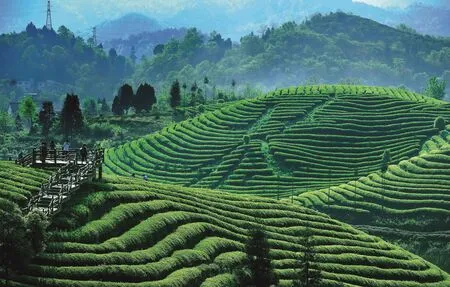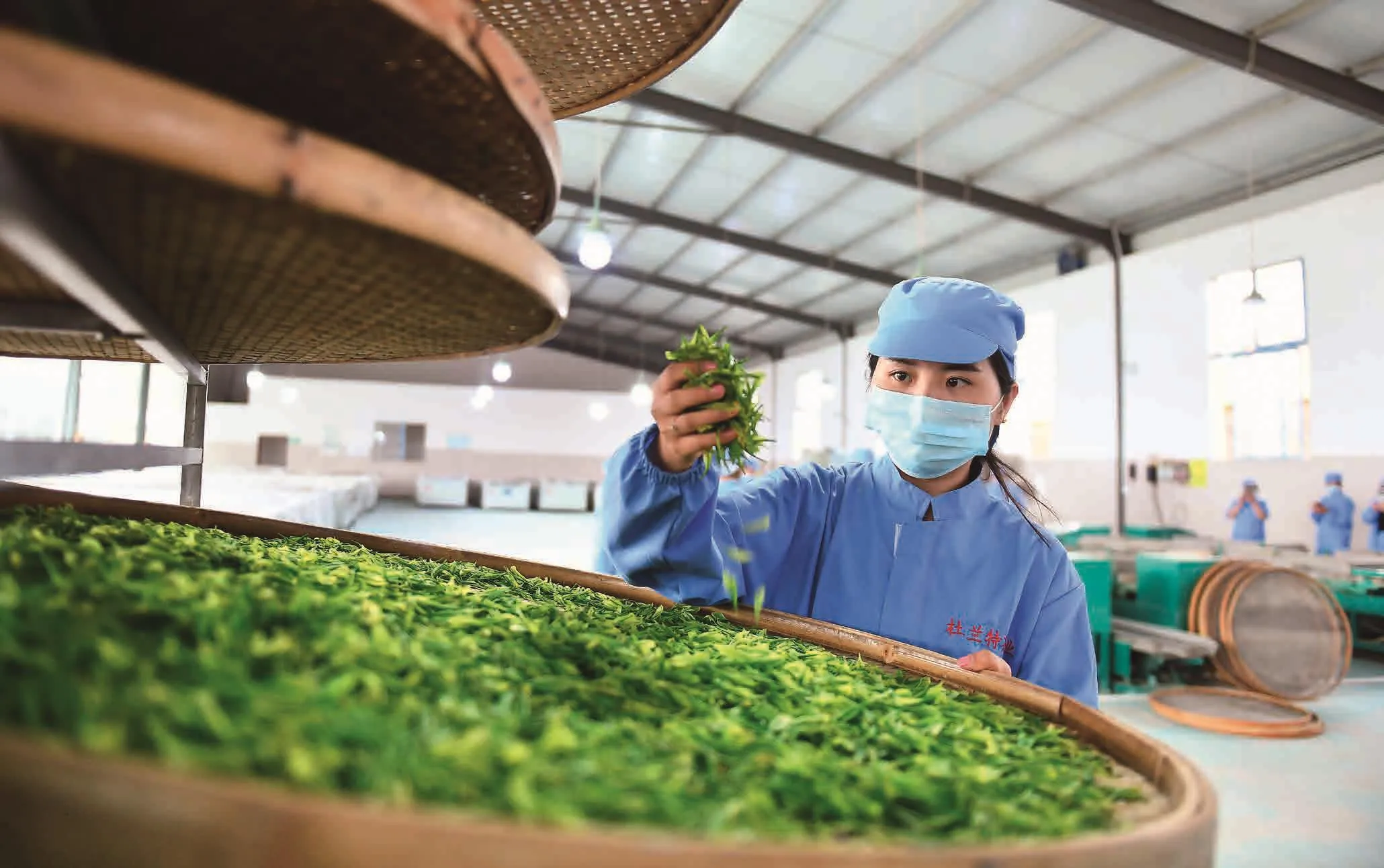高原茶旅 踏歌而行
◇ 文| 图|

茶是用来泡的。殊不知,茶也是拿来旅行的。
就像贵州。跟随中国画报协会的同行走进古夜郎,连片的茶园踏歌而来,“茶旅融合”成为“多彩贵州”的有机组成元素。
这是一场非常规的旅行。单纯而不单调,清爽却不寡淡。
在贵州来一场与茶有关的旅行,必要的攻略不可少。话说,依时下考证,云贵高原和湖南的一部分,是世界茶叶的原产地。1980年,在贵州晴隆县,发现了迄今为止世界上仅存的唯一一颗茶籽化石,初步考证其历史在100万年以上。陆羽所著《茶经》关于茶叶出产地,有“黔中生思州、夷洲、播州、费州……往往得之,其味极佳”的记载。
古云,“积善之家,必有余庆。”贵州的产茶地,就有一个叫“余庆”的县,也是这次高原茶旅的首站。
下着小雨,位于海拔800米之上的山地茶园,云遮雾罩。这里是余庆县花山乡的贵之缘茶业基地,大片大片的茶绿之中,采茶人“点缀”其间,或红、或蓝、或黄的着装,成为视觉上最好的装点。
雾气蒸腾,如薄纱从新叶嫩绿的芽尖滑过。即便再无美感之人,此刻也会被这梦幻的景致所震撼。
移步去往一个叫“隔山门”的地方。连片的茶园与不远处的“飞龙湖”遥相呼应,极度契合中国传统的水墨意境。
这与相邻的凤冈县的“茶海之心”也极为相似。
自余庆前往凤冈,沿途总能看见“东有龙井、西有凤冈”这样的标语——出产“凤冈锌硒茶”的贵州凤冈,与出产“西湖龙井”的浙江杭州,牵手一片茶叶。
Tea is used through brewing. Hardly imagine, tea is also used for journey.
Just like in Guizhou. Following colleagues from China Association of Pictorials into ancient Yelang, walking and singing along the stretches of tea gardens, the "integration of tea and tourism" became an organic element of "Colorful Guizhou".

↑ 布依姑娘采茶

凤冈锌硒茶

都匀毛尖茶
This was an unconventional journey. Simple but not monotonous, refreshing but not dull.
For a tea-related journey in Guizhou, travel strategy is absolutely necessary. According to current research, Yunnan-Guizhou Plateau and part of Hunan are the origin of tea in the world. In 1980, the only remaining tea seed fossil in the world was found in Qinglong County, Guizhou Province, and after preliminary research, its history dates back to over 1 million years ago. The Book of Tea by Lu Yu has a record on the origin of tea which goes that "the origin of tea in central Guizhou, Sizhou, Yizhou, Bozhou and Feizhou… are often where they are obtained and have excellent taste".
An old saying goes "Virtuous individuals and families are often more blessed with good fortune."There is a county called "Qingyu" in Guizhou where tea is produced, which is also the first stop of this journey to highland tea.
It was drizzling, and the mountain tea garden,located 800 meters above sea level, was shrouded in clouds and fog. This is the tea industry base in Huashan Town, Yuqing County, where tea pickers "adorned" the large stretches of tea plantation, either dressed in red,blue or yellow, making it the best visual decoration.
Floating mist like tulle flows through the green shoot tips of new leaves. Even those who have no aesthetic sense will be amazed with this dreamy scene at the moment.
We moved to a place called "Geshanmen". The stretches of tea gardens and the nearby "Feilong Lake" echoed each other from afar and were extremely compatible with the artistic conception of Chinese traditional ink painting.
This was also extremely similar to the "Heart of Tea Sea" in the neighboring Fenggang County.
From Yuaing to Fenggang, we could always see the slogan "Longjing in East China and Fenggang in West China"-Fenggang, Guizhou, which produces"Fenggang Zinc and Selenium Tea", and Hangzhou of Zhejiang province, which produces "West Lake Longjing Tea", were connected through a leaf of tea.
其实,“茶海之心”是凤冈一大片茶园茶山的统称。登上仙人岭,翠绿的茶园尽收眼底,一行一行茶树,让茶园有了极具美感的波浪式线条。尚未来得及采摘的茶叶嫩芽,鹅黄色,远观如带,成为茶园最好的点睛之笔。散落在茶海中的民居,更添田园画风。
从余庆到凤冈,从凤冈到湄潭,一路行来,虽都是看茶,却各有各的妙处与个性,比如余庆的“水墨”,凤冈的“田园”,湄潭的“大气”。
都匀又不同。作为此行最后一站,此处茶园营造的视觉美感,多了一分山地的壮观。都匀备选的茶旅去处太多,我们最后选择了一个叫螺丝壳的茶产业基地。螺丝壳的茶叶都种植在坡度较大的山地上,择任一山头登顶,四周茶绿扑面而来。时下,如余庆的松烟镇二龙村、凤冈的“茶海之心”一样,螺丝壳茶产业基地早已打造成“茶旅融合”的景区。

都匀螺蛳壳茶山

“春来喜看贵茶绿”采访团走进余庆县
基地所在地,属都匀市毛尖镇。那里原本叫总阳,与另一个乡镇合并后,叫了“毛尖镇”——“都匀毛尖”系中国十大名茶之一,镇以茶名,自是情理之中。
一场茶叶之旅,“看茶”仅是养眼,“品茶”慰劳舌尖。
贵州茶有“三绿一红”之说。“三绿”指的是都匀毛尖、湄潭翠芽、凤冈绿宝石,“一红”就是“遵义红”。此行每至一处,流连茶园茶山,寻一歇脚处,泡上一杯贵州绿茶,立马有了“一杯春露香透齿”的感觉。
听当地研究者说,旧时贵州大部分地区有“以茶为聘”“茶定终身”的婚俗规制,俗称“三回九转”。“三回”:放信茶,亦称头书;二道茶,亦称允书;三道茶,亦称庚书。在“三茶”基础上,再完成“六礼”,即“纳彩、问名、纳喜、纳征、请期、亲迎”。“三茶”加上“六礼”即为“九转”,是为“三回九转”。茶叶在贵州民俗中的重要性可见一斑。

如今,旧俗早已不存,茶叶担当起了新的产业角色,700万亩茶园已投产561万亩,产量36.2万吨,总产值394亿元。茶叶本身,以及日渐成熟的“茶旅融合”,对产茶地的乡亲来说,更是脱贫致富的希望。
In fact, “the Heart of the Tea Sea” is a joint name for a large stretch of tea gardens and mountains in Fenggang. Climbing Xianrenling, you could have a panoramic view of the green tea gardens, with rows of tea trees,giving the tea gardens a very beautiful wavy line. The tender shoots of the tea leaves, which had not yet been picked, were yellow and looked like a belt from afar,making them the best finishing touch in the tea garden.The folk houses scattered in the tea sea accentuated the pastoral style.
All the way long from Yuqing to Fenggang, from Fenggang to Meitan, although they were tea watching,each had its own merits and features, such as Yuqing’s“ink painting”, Fenggang’s “pastoral style” and Meitan’s “spectacular sight”.
While Duyun is different. As the last stop of this journey, the visual beauty created by the tea gardens here was a bit more spectacular in term of the mountain.Duyun has too many places for tea journeys to choose from, so we finally chose a tea industry base called Luosike. The tea of Luosike are all planted on the mountain with a large slope, and at any mountain top when you mounted, you would be overwhelmed by the tea green plantation around. At present, like the “Heart of the Tea Sea” in Erlong Village of Songyan Town of Yuqing and Fenggang, the tea industry base of Luosike had long been a scenic spot for “integration of tea and tourism”.
The base is located in Maojian Town of Duyun City.It was originally called Zongyang and after merging with another township, it was called Maojian Town-”Duyun Maojian” is one of the top ten famous teas in China. It is natural that the town is named after tea.
For a journey to tea, “tea watching” is only to please the eyes and “tea tasting” delights the tip of the tongue.
Guizhou tea has the saying of “Three Greens and One Red”. “Three Greens” refers to Duyun Maojian,Meitan Cuiya and Fenggang Emerald, “One Red” refers “Zunyihong (or Zunyi Red)”. At every place of the journey, I would linger in the tea garden, find a place to rest and make a cup of Guizhou green tea, which immediately made me feel “a cup of spring dew refreshing the teeth”.
According to local researchers, in the old days,most areas in Guizhou had a marriage custom of “betrothing through tea” and “tea determines marriage life”, commonly known as “Three Rounds and Nine Turns”. “Three Rounds”: Fangxincha (trusting tea),also known as Toushu; the second round of tea, also known as Yunshu; the third round tea, also known as Gengshu. On the basis of the “Three Teas”, the “Six Rites” would be completed, namely, “receiving betrothal gifts, asking for the name and birth date, practicing divination, receiving betrothal presents,proposing marriage date, and greeting and receiving the bride by bridegroom personally”. “Three Teas” plus “Six Rites” means “Nine Turns”, which are called “Three Rounds and Nine Turns”, which shows the importance of tea in Guizhou folk customs.
Today, the old customs have long been gone, and tea has taken on a new industrial role. The 5.61 million Mu of 7 million Mu tea garden has been put into production, yielding 362,000 tons with a total output value of 39.4 billion RMB Yuan. The tea itself and the maturing“integration of tea and tourism” are more of hope for villagers in the tea-producing areas to shake off poverty and become rich.

